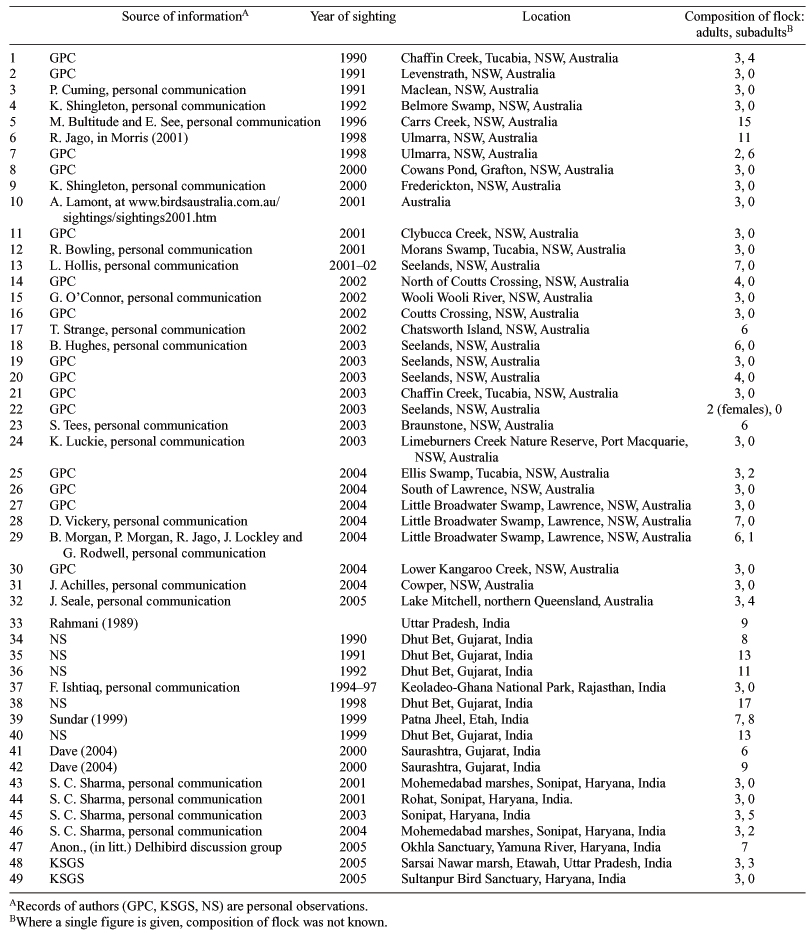Factors affecting formation of flocks of unusual size and composition in Black-necked Storks (Ephippiorhynchus asiaticus) in Australia and India
K. S. Gopi Sundar A , Greg P. Clancy B D and Nita Shah CA Indian Cranes and Wetlands Working Group, c/o International Crane Foundation, E-11376, Shady Lane Road, Baraboo, WI, 53913, USA, and Wildlife Protection Society of India, S-25, Panchsheel Park, New Delhi, 110017, India. Email: gopi@savingcranes.org
B Department of Zoology, School of Environmental Sciences and Natural Resources Management, University of New England, National Marine Science Centre, c/o PO Box 63, Coutts Crossing NSW, 2460, Australia.
C Vulture Advocacy Programme, Bombay Natural History Society, A-309, Yamuna Apartments, Alakananda, New Delhi, 110019, India.
D Corresponding author. Email: gclancy@tpg.com.au
Emu 106(3) 253-258 https://doi.org/10.1071/MU05014
Submitted: 21 March 2005 Accepted: 3 May 2006 Published: 18 August 2006
Abstract
The Black-necked Stork (Ephippiorhynchus asiaticus) usually occurs singly, in pairs or in family groups, and only very rarely in flocks. We describe records of flocks of this species in the Australian and Indian subspecies and discuss the possible reasons for their occurrence. Records of flocks were fewer from India, but flock-sizes were significantly larger. Factors related to flock formation, such as season, habitat quality and water availability, differed between Australia and India. Flocks occurred predominantly in autumn in Australia, whereas there was no relationship between season and flocking in India. Flock-sizes did not differ seasonally for either subspecies or between subspecies. Flocks were composed either of adults only or combinations of young birds and adults. In Australia, occurrence of different types of flocks was not affected by season or habitat. A combination of season and local habitat conditions appear to be affecting formation of flocks in this species.
Acknowledgments
We gratefully acknowledge the contribution of all the people who shared their unpublished field observations for this paper. K. S. G. Sundar thanks Shashi and M. S. Rana at the Wildlife Institute of India for library assistance, R. Chauhan, Deepu and A. Verma for various help during fieldwork, the International Crane Foundation and the Wildlife Protection Society of India for providing facilities during the writing of this paper, and S. Kittur for various help. G. P. Clancy thanks W. Thompson, R. Jago and V. Clancy for assistance with fieldwork. We thank M. C. Coulter, H. Ford, R. Kingsford, G. Maheshwaran and two anonymous reviewers for providing discussions and critique that improved earlier drafts of the manuscript.
Frederick, P. C. , Sandoval, J. C. , Luthin, C. , and Spalding, M. (1997). The importance of the Caribbean coastal wetlands of Nicaragua and Honduras to central American populations of waterbirds and Jabiru storks (Jabiru mycteria). Journal of Field Ornithology 68, 287–295..
Garnett, S. , and Bredl, R. (1985). Birds in the vicinity of Edwards River Settlement. Sunbird 15, 6–40.
Ishtiaq, F. , Rahmani, A. R. , Javed, S. , and Coulter, M. C. (2004). Nest-site characteristics of Black-necked Storks (Ephippiorhynchus asiaticus) and White-necked Stork (Ciconia episcopus) in Keoladeo National Park, Bharatpur, India. Journal of the Bombay Natural History Society 101, 90–95.
Morris, A. K. (2001). New South Wales Annual Bird Report for 1998. Australian Birds 33, 101–167.

Morton, S. R. , Brennan, K. G. , and Armstrong, M. D. (1993). Distribution and abundance of Brolgas and Black-necked Storks in the Alligator River region, Northern Territory. Emu 93, 88–92.

Rahmani, A. R. (1989). Status of the Blacknecked Stork Ephippiorhynchus asiaticus in the Indian subcontinent. Forktail 5, 99–110.

Sundar, K. S. G. (1999). Black-necked storks, Sarus Cranes and Drongo-cuckoos. Newsletter for Birdwatchers 39 (5 Sept.–Oct.), 71–72.

Sundar, K. S. G. (2003). Notes on the breeding biology of Black-necked Storks Ephippiorhynchus asiaticus in Etawah and Mainpuri districts, Uttar Pradesh, India. Forktail 19, 15–20.

Sundar, K. S. G. (2004). Group size and habitat use by Black-necked Storks Ephippiorhynchus asiaticus in an agriculture dominated landscape in Uttar Pradesh, India. Bird Conservation International 14, 323–334.
| Crossref | GoogleScholarGoogle Scholar |

Sundar, K. S. G. (2005). Effectiveness of road transects and wetland visits for surveying Black-necked Storks Ephippiorhynchus asiaticus and Sarus Cranes Grus antigone in India. Forktail 21, 27–32.

Sundar, K. S. G. , Deomurari, A. , Bhatia, Y. , and Narayanan, S. P. (in press.). Records of Black-necked Storks Ephippiorhynchus asiaticus breeding pairs fledging four chicks. Forktail ,


|

